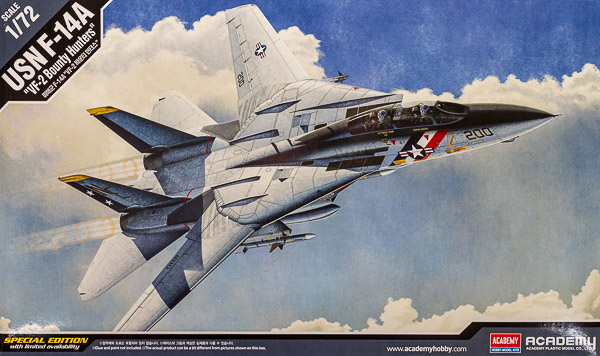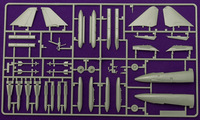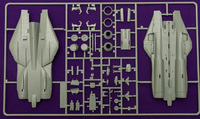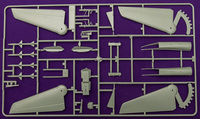
Academy 1/72 USN F-14A "VF-2 Bounty Hunters"
By Chris Banyai-Riepl
Overview
The Grumman F-14 is a US Navy icon, developed out of the combat experience during the Vietnam War. The design evolved to become the ultimate USN air superiority fighter, capable of engaging enemy aircraft from beyond visual range with its Phoenix missiles or up close with its 20mm Vulcan gun. The F-14 began replacing the F-4 Phantom in 1974, and remained in service for decades, with the final Tomcat retiring in 2006.
The Kit
The F-14 is one of those popular subjects that just about everyone produces a kit of, and there are no shortages of options in 1/72. The Academy kit is right in the middle of the pile when it comes to accuracy and detail, with one of the better sets of air-to-air weapons, a decent cockpit, and recessed detail throughout. It does lack the dropped flaps and slats found in the Hasegawa kit, though, and the extra details like the engines found in the Fujimi kit, but it's also much cheaper than either of those options. This release comes with colorful VF-2 "Bounty Hunters" markings from 1993 and more sedate VF-102 "Diamondbacks" markings from 1982.

|

|
Jumping into the build, all F-14 kits have odd assembly processes, all due to the unique design of the Tomcat. In most cases, this means a separate nose section and split upper and lower rear fuselage section, and this kit is no different. So starting with that nose section, this gets a pretty nice cockpit tub. The seats are nicely detailed, with separate cushion sections matching up to seat side pieces, all capped by a separate seat top with ejection handles. The instrument panels have the basic shape molded in, with all the details provided as decals. The sidewalls are similarly treated, and all together this will make for a nice looking out-of-box closed canopy interior. The finished cockpit then fits on to the top of the nose gear well insert, and both are inserted into the two nose halves. Once that's together, there are separate pieces to fit on the instrument hood and center section between the seats.
Once the front end is done, the rest of the assembly will go pretty quick. The wings are split into upper and lower pieces, and have gears to have them moveable. Once those are lined up right, the upper and lower rear fuselage halves can go together and the engine intakes and nose can be added. On the back end, there are two options for the exhaust cans, while the underside has some nicely detailed landing gear. Of course, the other big underside addition are the weapons, and this kit comes with two fuel tanks, a reconnaissance pod, four AIM-54 Phoenix missiles, four AIM-9 Sidewinder missiles, and four AIM-7 Sparrow missiles.

|

|
For decals, the sheet comes with a lot of extra stenciling and details in addition to the main markings, which is nice to see. The boxtop VF-2 option is from 1993 off the USS Ranger. It features the original high visibility scheme worn by the first VF-2 Tomcats, with broad red, white, and blue stripes on the forward fuselage and a black rudder with white stars. This version is overall gull gray and is a very clean looking plane. For those who might want to do a bit more with weathering, the second option is from VF-102, also off the USS Ranger, but from 1982. This is a standard squadron bird, finished in overall gull gray with simple red diamondback markings. The decals are nicely printed with excellent color and registration.
Conclusion
For someone looking for a fairly simple and inexpensive 1/72 Tomcat kit, the Academy kits are hard to beat. Out of the box they look like a Tomcat, and can go together quickly. While those wanting a show stopper build will likely choose the Hasegawa kit, a lot of fun can still be had with this one. My thanks to MRC for the review sample.
